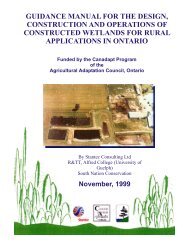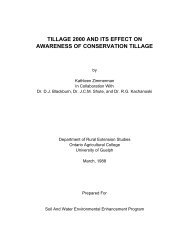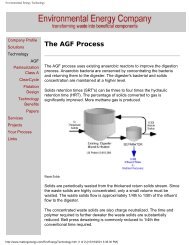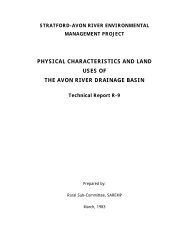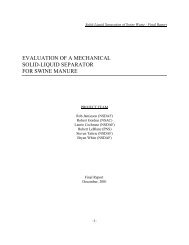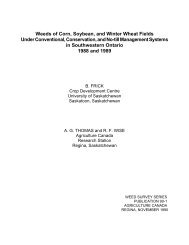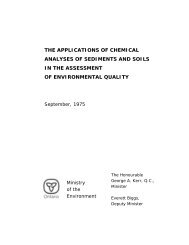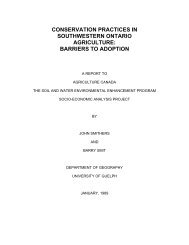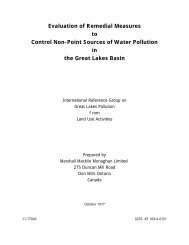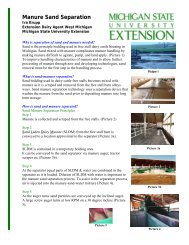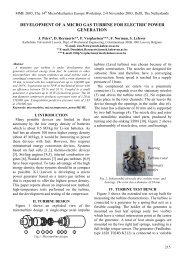Environmental Aspects of Phosphate and Potash Mining United ...
Environmental Aspects of Phosphate and Potash Mining United ...
Environmental Aspects of Phosphate and Potash Mining United ...
Create successful ePaper yourself
Turn your PDF publications into a flip-book with our unique Google optimized e-Paper software.
The <strong>Environmental</strong> Approach <strong>of</strong> the <strong>Phosphate</strong> Rock <strong>and</strong> <strong>Potash</strong> <strong>Mining</strong> Industry<br />
40<br />
Pit Wall Erosion Control<br />
Heavy weathering <strong>of</strong> the overburden <strong>and</strong> orebody at<br />
the Catalão phosphate rock mine <strong>of</strong> Copebras S.A.<br />
means the pit walls are extremely prone to erosion<br />
creating concern about the stability <strong>of</strong> the 80 metre<br />
high final pit walls. The company has implemented a<br />
number <strong>of</strong> measures in response.<br />
Temporary internal pit walls are designed <strong>and</strong> excavated<br />
to a steeper overall slope. As excavation occurs<br />
against the designed pit limits, the pit wall slopes are<br />
flattened to enhance long-term stability. Final pit walls<br />
are designed with an overall slope <strong>of</strong> 34o, consisting<br />
<strong>of</strong> five metre wide catch berms placed every five<br />
metres vertically, with an intervening wall slope <strong>of</strong><br />
60o. The catch berms are sloped back into the pit wall<br />
to capture any rainfall <strong>and</strong> prevent erosion <strong>of</strong> the pit<br />
wall by run-<strong>of</strong>f. Excess water collecting on the berms is<br />
transferred to the bottom <strong>of</strong> the pit through a series <strong>of</strong><br />
pipe drains constructed from 44-gallon drums welded<br />
together. The berms are vegetated to enhance stability.<br />
The approach leaves a final pit wall that resists the<br />
erosion effects <strong>of</strong> rainfall, enhancing establishment <strong>of</strong><br />
vegetation <strong>and</strong> long-term stability.<br />
Final pit wall with drains - Copebras S.A., Brazil<br />
Beneficiation waste disposal impoundments, dams,<br />
<strong>and</strong> ponds may contain materials that may present an<br />
ongoing threat to the environment if not rehabilitated<br />
effectively.<br />
At some operations, the clay fines generated during<br />
beneficiation <strong>of</strong> phosphate rock are drained <strong>and</strong><br />
allowed to consolidate. L<strong>and</strong>scaping is required to<br />
establish suitable drainage. The clay fines may be suitable<br />
for conversion to agricultural l<strong>and</strong> due to the<br />
elevated phosphate levels <strong>and</strong> good water retention<br />
properties, grassl<strong>and</strong> or forest.<br />
<strong>Potash</strong> salt tailings present an ongoing issue due to the<br />
potential for dissolution <strong>of</strong> the salt by rain. In<br />
response to this, a number <strong>of</strong> rehabilitation methods<br />
have been implemented including dissolution <strong>of</strong> the<br />
salt, disposal <strong>of</strong> the resulting brines <strong>and</strong> capping <strong>of</strong> the<br />
salt pile with impermeable layers.<br />
Commonly, the surface <strong>of</strong> shafts are capped to prevent<br />
humans or wildlife falling into them. In potash mines,<br />
shafts are sealed just above the orebody to prevent<br />
water from overlying aquifers entering, dissolving ore,<br />
<strong>and</strong> presenting a future water contamination issue.<br />
Sealing <strong>of</strong> Decommissioned Shafts<br />
Kali und Salz GmbH in Germany has conducted<br />
research into the sealing <strong>of</strong> disused potash mine<br />
shafts, in partnership with a local University. The purpose<br />
<strong>of</strong> the shaft sealing is to prevent water from<br />
entering the orebody <strong>and</strong> dissolving salts from the<br />
evaporite beds. If this occurs the overlying aquifers<br />
may become contaminated with salt.<br />
Research has focused on the use <strong>of</strong> bentonite clay<br />
plugs placed in the shaft above the evaporite horizons.<br />
Water coming into contact with the bentonite<br />
will cause it to swell, sealing any possible paths <strong>of</strong><br />
ingress.<br />
Vegetated pit wall - Copebras S.A., Brazil<br />
Revegetation<br />
Revegetation is typically conducted to stabilize the disturbed<br />
areas <strong>and</strong> prevent wind <strong>and</strong> water erosion. This<br />
can vary from planting or seeding with a single grass<br />
species, conversion to agricultural or forestry purposes,<br />
through to the establishment <strong>of</strong> quite complex<br />
ecosystems involving upl<strong>and</strong> forests, grassl<strong>and</strong>s <strong>and</strong><br />
wetl<strong>and</strong>s. Where natural ecosystems are being reestablished,<br />
native species tend to be used, but faster<br />
growing non-native grass species are sometimes used



